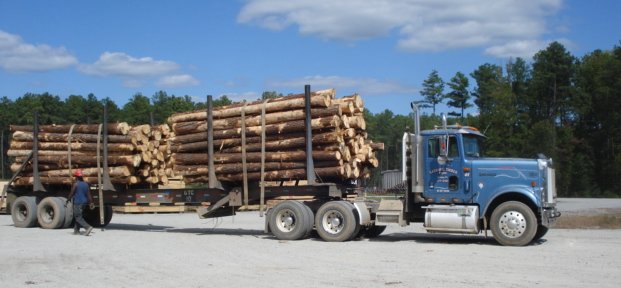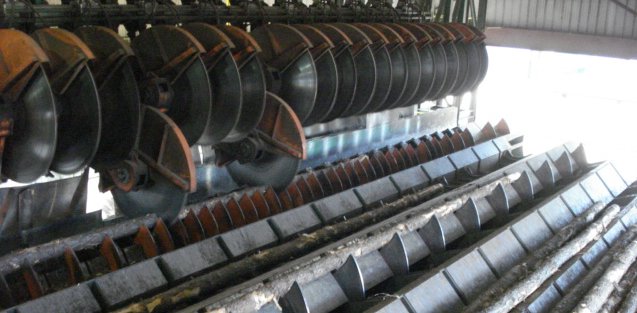
Above – wood from nearby tree farms arrives at the mill.
Saw mills have changed. Machines, computers and robots have replaced the army of unskilled workers and the dirty and dangerous jobs are mostly gone. The ArborTech saw mill near Blackstone, Virginia runs three shifts with only eighty workers. I was interested in looking at the plant, since it processes loblolly pine (which I grow) and gets its timber within a sixty mile radius of the plant. Both my timber tracks are within that zone.
Below – The giant hook loads the logs. The initial processing can handle a log every 2-3 seconds.

The plant is run by a couple of partners who established it in Nottoway County in 2001. They chose the location on the northern edge of the great loblolly pine forests. There is lots of renewable wood resource available to the south and good markets to the north.
Below – They switched from oil to sawdust, produced as a by-product of the mill. You can see from the smokestack that it makes almost no pollution and it is carbon neutral.

Loblolly pine grows fast and is strong enough for structural timber. Southern pine (which includes loblolly, slash and longleaf pine), also called yellow pine, satisfies around 58% of America’s timber needs. We can grow this resource, sustainably, essentially forever. I am glad to have an efficient mill near my property. Below are some pictures and explanatory texts.
Below the computer decides where to saw to get the most straight wood.

Below is the guy running the computer to do that sawing.

Below – the boards move out just after they are cut. The warehouse is very tidy and clean.

Below – the boards are cut with this bandsaw. The computer keeps it sharp.

Modern industry is so different from what I remember. It is much cleaner and automated. Despite all the talk about the decline of American industry, American industrial production is actually higher than it was twenty years ago. But industrial employment has plumeted. When you go to a modern plant, you can see why. A lot of product is coming out of the plant, but there are not many people working there. Industry will be like agriculture. In the past almost everybody had to work on the farms. Today less than 2% of the workforce does. Yet they produce enough to feed us and much of the rest of the world. Productivity means fewer jobs to produce more stuff. That is good, but it sometimes hurts.
